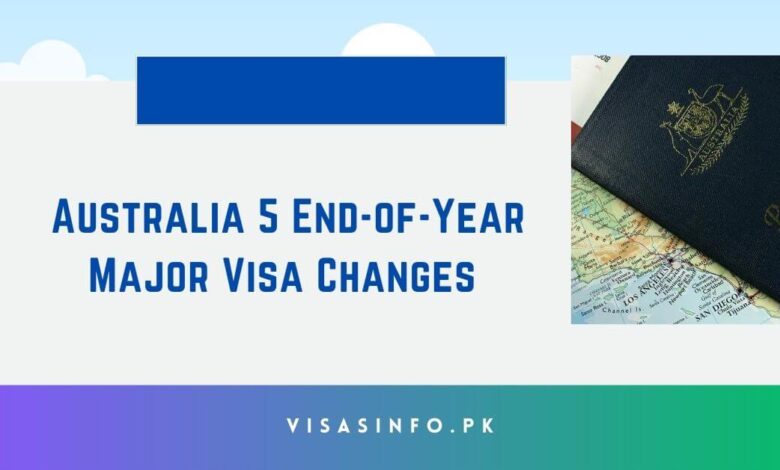Australia 5 End-of-Year Major Visa Changes – Check Here

We will examine the most recent developments in the employer-sponsored sector as 2023 concludes and provide you with an understanding of the Australian government’s immigration policy.
1. Pathway to PR for 482 Visa Holders
The subclass 186 Employer Nomination Visa Temporary Residence Transition Stream now provides all bearers of subclass 482 visas with a pathway to permanent residency, regardless of their occupation. Similarly to the Subclass 482 Visa, this Employer Sponsored Visa necessitates two components: a nomination and an application.
The individual on a 482 Visa must have fulfilled the job responsibilities for a minimum of two years. Additionally, the employees are required to maintain their operations for a minimum of two years following the issuance of the visa, and their salaries must exceed the new temporary skilled migration income criterion of $70,000. Regulations concerning the application deadline for individuals who possess 482 short-term visas, which are applicable for two years, are currently pending.
2. Introduction of New Visa
The Subclass 482 Visa will soon be closed to new applicants. In its substitute, a new Skills In-Demand Visa will be implemented. Although there will be numerous distinctions between this visa and Subclass 482, the following modifications are substantial, and consultation is still necessary in certain circumstances:
A monthly payment plan is currently being investigated as a potential alternative to upfront expenses, such as those associated with the Skilling Australia Fund, pending additional feedback. During the 180-day period in which visa holders are required to secure new employment, they are permitted to continue working for any approved employer, as this will contribute to their permanent residency.
The public will have access to an authorized sponsor registry that contains information regarding the number of migrants supported and their occupations.
3. Migration Strategy
The skilled migration program and company policies were the primary focus of the migration strategy that was recently released. The strategy’s primary objectives include the enhancement of living standards, the establishment of workplace equity, the development of stronger Australian communities, the strengthening of partnerships with other nations, and the simplification of the immigration process.
The government of Australia has released its 10-year migration policy, which delineates the nation’s current migration figures and any suggested modifications. After reaching a high of 510,000 in the previous fiscal year, it is anticipated that Australia’s net migration will decrease to more typical levels, with 250,000 in 2025 and 375,000 in the following year.
The Australian government’s new migration policy has undergone numerous notable improvements, some of which are specifically designed to benefit migrant laborers.
4. Working Holiday Makers
A six-month work restriction will be lifted for working holiday visa holders who commenced employment with an organization before July 1, 2023, on December 31, 2023. Previously, the work restriction was subject to certain exceptions, including the cultivation of plants and animals, employment in highly sought-after industries in Northern Australia, and employment in multiple locations as long as one location was occupied for no more than six months at a time.
The Department of Home Affairs’ most recent materials indicate that there are no exceptions to the six-month work prohibition. The department anticipates that the Minister’s office will implement temporary policy settings to resolve this matter. These will be communicated as soon as they are accessible.
5. Labor Market Testing
Testing for the employment market has transformed. The changes, which take effect on December 11, eliminate the necessity of posting job advertisements for all designated openings on the Workforce Australia website and establish the parameters for overlap and advertising. This is referred to as an overlapping advertisement when an advertisement is initially broadcast on a platform for 14 days and subsequently rebroadcast for an additional 14 days to satisfy the statutory 28-day duration.
For labor market testing, these advertisements must overlap by a minimum of one day, and the number of overlapping days is only used once. If, for instance, a 14-day advertisement was posted on December 1, an additional 14-day advertisement would be required to be posted on December 14.
Ministerial Direction Number 105?
The Australian government has issued Ministerial Direction 105, a set of guidelines that prioritize certain professional visa applicants over others. This implies that if your application is classified as a priority area, you may anticipate a more expedited processing time and a simpler route to attaining your Australian goal.
The objective of Ministerial Direction Number 105 is to attract skilled laborers to industries that are essential to Australia’s economic expansion, including engineering, healthcare, and information technology. If your field of employment is one of these priority areas, you may experience quicker processing times as your application may be reviewed before those of others.
By reducing the amount of paperwork and simplifying the process, the Australian government may expedite the application process for you. Furthermore, there is a higher probability of your application being approved.
Key Points of Ministerial Direction Number 105
1. The primary elements of this new Visa policy are as follows:
Acknowledgment of the necessity to streamline the visa application process
The Australian government has recognized the significance of simplifying the visa application process for regional Australian businesses that employ skilled personnel. This policy prioritizes applications for employer-sponsored visas and employment opportunities in regional Australia. It includes the Employer Nomination Scheme (Subclass 186), the Skilled Employer Sponsored Regional Provisional Visa (Subclass 494), and the Temporary Skill Shortage Visa (Subclass 482).
2. Prioritizing applications for specific occupations
Applications for visas relevant to employment in the healthcare and education sectors continue to be prioritized, with no discernible effect on the processing time for these occupations. The list of prioritized occupations within these sectors remains unchanged.
3. Sponsors who possess accredited status are granted priority.
Under the most recent version of the Australian government’s Certified Sponsorship Program, strategic financial preference awards are granted to businesses that have acquired venture capital to facilitate the development of pathways to permanent residents and expedite procedures. This represents a departure from the previous process, which prioritized offshore applications for permanent visas over onshore applications.
4. Deletion of priority classification for specific passport holders
To enhance overall efficiency, the priority status of certain eligible passport bearers was revoked. British nationals residing abroad and Hong Kong citizens continue to be protected by this. For a comprehensive list of all visa subclasses under each category that are subject to Ministerial Direction number 105, please refer to the skilled Visa processing priorities section of the Australia Home Affairs website.
Check Also: Australian Skills In-Demand Visa for Foreigners
Benefits of
- Financial Relief: Scholarships can substantially reduce the cost of tuition, thereby making higher education more accessible and easing the financial burden on students and their families.
- Academic Excellence Recognition: A significant number of scholarships are merit-based, acknowledging students for their academic accomplishments, leadership abilities, or extracurricular activities. This can improve a student’s resume and increase their self-assurance.
- Access to Better Opportunities: Scholarships may provide students with the financial support necessary to concentrate on their studies, enroll in internships, or engage in other academic and extracurricular activities that can enhance their career prospects.
- Diversity Promotion: Scholarships can be instrumental in attracting and supporting a diverse student body, thereby enriching the learning environment and offering opportunities for students from a variety of backgrounds to succeed.
- Networking and Development: Certain scholarships offer supplementary benefits, including mentorship programs, networking events, and seminars, which can assist students in establishing valuable connections and enhancing their professional abilities.
- Reduced Student Debt: Scholarships may enable students to reduce or avoid the need for loans, thereby reducing the quantity of student debt they accumulate during their academic careers.
- Enhanced Motivation: Scholarships can be used as a motivating tool to motivate students to maintain high academic standards and attain their personal and professional objectives.
Frequently Asked Questions:
-
What are the latest changes to student visas in Australia?
Under the new regulations, visitors, temporary graduate visa holders, and other specified visa holders currently in Australia are not eligible to apply for student visas. However, these new rules will not affect student visa applications submitted within Australia before July 1, 2024.
-
Is Australia reducing student visas?
Australia will stop converting tourist visas to student status starting next month, continuing a series of policies aimed at reducing immigration.
-
What are the new visa rules?
The UK is introducing new immigration rules throughout 2024, which include raising the salary requirement for skilled worker visas to £38,700 per year on 4 April 2024 and for spouse visas to £29,000 on 11 April 2024, as well as placing restrictions on holders of healthcare and care worker visas and international student visas.



